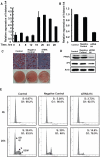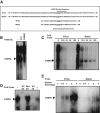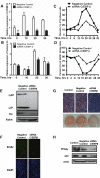Transcriptional activation of histone H4 by C/EBPβ during the mitotic clonal expansion of 3T3-L1 adipocyte differentiation
- PMID: 21562223
- PMCID: PMC3128520
- DOI: 10.1091/mbc.E10-11-0912
Transcriptional activation of histone H4 by C/EBPβ during the mitotic clonal expansion of 3T3-L1 adipocyte differentiation
Abstract
CCAAT enhancer binding protein β (C/EBPβ) is required for both mitotic clonal expansion (MCE) and terminal differentiation during the 3T3-L1 adipocyte differentiation program. Whereas the mechanism of C/EBPβ during terminal differentiation is well understood, the mechanism of C/EBPβ in MCE is not. We provide evidence that histone H4, the most conserved cell cycle-related histone, the change of which is strictly correlated with DNA content change during the cell cycle, is transcriptionally activated by C/EBPβ during MCE. Expression of histone H4 is increased at 16 h after induction when 3T3-L1 preadipocytes synchronously reenter S phase, which is correlated with the sequential phosphorylation and activation of C/EBPβ, and expression was partially suppressed when A-C/EBP (dominant negative for C/EBP protein) was overexpressed. One C/EBP-binding site was identified in one of the histone H4 gene promoters (hist4h4), confirmed by both electrophoretic mobility shift assay and chromatin immunoprecipitation assay. C/EBP-binding sites were also found in 9 of 11 other histone H4 promoters, which can also be transactivated by C/EBPβ. Knockdown of C/EBPβ by stealth small interfering RNA partially decreased H4 gene expression and arrested cells in G1 phase as indicated by bromodeoxyuridine incorporation and fluorescence-activated cell sorting analysis of DNA content. This study provides new insights into why C/EBPβ is required for MCE during 3T3-L1 adipocyte differentiation and why C/EBPβ plays important roles in the proliferation of other cell types.
Figures








Similar articles
-
Transcriptional regulation of adipocyte differentiation: a central role for CCAAT/enhancer-binding protein (C/EBP) β.J Biol Chem. 2015 Jan 9;290(2):755-61. doi: 10.1074/jbc.R114.619957. Epub 2014 Dec 1. J Biol Chem. 2015. PMID: 25451943 Free PMC article. Review.
-
Histone demethylase Kdm4b functions as a co-factor of C/EBPβ to promote mitotic clonal expansion during differentiation of 3T3-L1 preadipocytes.Cell Death Differ. 2012 Dec;19(12):1917-27. doi: 10.1038/cdd.2012.75. Epub 2012 Jun 22. Cell Death Differ. 2012. PMID: 22722334 Free PMC article.
-
Dominant-negative C/EBP disrupts mitotic clonal expansion and differentiation of 3T3-L1 preadipocytes.Proc Natl Acad Sci U S A. 2004 Jan 6;101(1):43-7. doi: 10.1073/pnas.0307229101. Epub 2003 Dec 19. Proc Natl Acad Sci U S A. 2004. PMID: 14688407 Free PMC article.
-
Reactive oxygen species facilitate adipocyte differentiation by accelerating mitotic clonal expansion.J Biol Chem. 2009 Apr 17;284(16):10601-9. doi: 10.1074/jbc.M808742200. Epub 2009 Feb 23. J Biol Chem. 2009. PMID: 19237544 Free PMC article.
-
Role of the CCAAT enhancer binding proteins (C/EBPs) in adipocyte differentiation.Biochem Biophys Res Commun. 1999 Dec 29;266(3):677-83. doi: 10.1006/bbrc.1999.1885. Biochem Biophys Res Commun. 1999. PMID: 10603305 Review.
Cited by
-
Histone demethylase KDM5A is transactivated by the transcription factor C/EBPβ and promotes preadipocyte differentiation by inhibiting Wnt/β-catenin signaling.J Biol Chem. 2019 Jun 14;294(24):9642-9654. doi: 10.1074/jbc.RA119.008419. Epub 2019 May 6. J Biol Chem. 2019. PMID: 31061100 Free PMC article.
-
Transcriptional regulation of adipocyte differentiation: a central role for CCAAT/enhancer-binding protein (C/EBP) β.J Biol Chem. 2015 Jan 9;290(2):755-61. doi: 10.1074/jbc.R114.619957. Epub 2014 Dec 1. J Biol Chem. 2015. PMID: 25451943 Free PMC article. Review.
-
Molecular Mechanisms of Adipogenesis: The Anti-adipogenic Role of AMP-Activated Protein Kinase.Front Mol Biosci. 2020 May 8;7:76. doi: 10.3389/fmolb.2020.00076. eCollection 2020. Front Mol Biosci. 2020. PMID: 32457917 Free PMC article. Review.
-
Neuromedin B receptor disruption impairs adipogenesis in mice and 3T3-L1 cells.J Mol Endocrinol. 2019 Jul;63(1):93-102. doi: 10.1530/JME-19-0032. J Mol Endocrinol. 2019. PMID: 31067509 Free PMC article.
-
Gomisin N inhibits adipogenesis and prevents high-fat diet-induced obesity.Sci Rep. 2017 Jan 9;7:40345. doi: 10.1038/srep40345. Sci Rep. 2017. PMID: 28067305 Free PMC article.
References
-
- Aziz F, van Wijnen AJ, Stein JL, Stein GS. HiNF-D (CDP-cut/CDC2/cyclin A/pRB-complex) influences the timing of IRF-2-dependent cell cycle activation of human histone H4 gene transcription at the G1/S phase transition. J Cell Physiol. 1998a;177:453–464. - PubMed
-
- Aziz F, van Wijnen AJ, Vaughan PS, Wu SJ, Shakoori AR, Lian JB, Soprano KJ, Stein JL, Stein GS. The integrated activities of IRF-2 (HiNF-M), CDP/cut (HiNF-D) and H4TF-2 (HiNF-P) regulate transcription of a cell cycle controlled human histone H4 gene: mechanistic differences between distinct H4 genes. Mol Biol Rep. 1998b;25:1–12. - PubMed
-
- Birnbaum MJ, et al. Functional role for Sp1 in the transcriptional amplification of a cell cycle regulated histone H4 gene. Biochemistry. 1995;34:7648–7658. - PubMed
-
- Borun TW, Pearson D, Paik WK. Studies of histone methylation during HELA S-3 cell cycle. J Biol Chem. 1972;247:4288. - PubMed
-
- Buck M, Poli V, Van Der Geer P, Chojkier M, Hunter T. Phosphorylation of rat serine 105 or mouse threonine 217 in C/EBP beta is required for hepatocyte proliferation induced by TGF alpha. Mol Cell. 1999;4:1087–1092. - PubMed
Publication types
MeSH terms
Substances
LinkOut - more resources
Full Text Sources
Molecular Biology Databases

